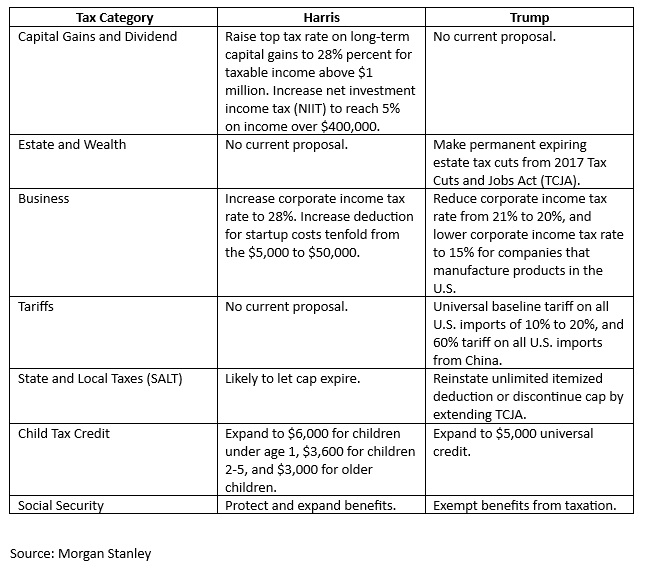With nail-biting days until the U.S. presidential election, investors and business owners are closely following the candidates' proposals, or lack thereof, on an array of tax topics. Vice President Kamala Harris and former President Donald Trump have been sharing snippets of their plans, but the bigger picture will not begin to evolve until after the election, as only Congress can make changes to tax law. There is potential for significant change if Congress does not extend the 2017's Tax Cuts and Jobs Act (TCJA) when it expires at the end of 2025.
Here's a basic look what the candidates have proposed to date.

Though Harris has proposed new tax and economic policies as part of her campaign platform, she has not said whether she will continue the same policies outlined in the Biden-Harris administration's fiscal year 2025 budget, or introduce different tax policy changes, such as hiking the top tax rate on capital gains income to 28%. Trump, meanwhile, has said he plans to extend all tax cuts from the TCJA bill he signed into law during his presidency.
Calculating the potential economic impact of both proposals is a source of wrangling among policy-watchers and number-crunchers. According to the Penn Wharton Budget Model (PWBM), Harris' tax and spending proposals would increase primary deficits by $1.2 trillion over the next decade on a conventional basis, and by $2 trillion on a dynamic basis that includes a reduction in economic activity. Trump's proposals would increase primary deficits by $5.8 trillion over the next decade on a conventional basis, and by $4.1 trillion on a dynamic basis that includes economic feedback impact, PWBM estimates.
Bottom line: Vowing to slash taxes has long been a primary source of debate among presidential candidates, even though the president lacks power to change any tax laws. Once the election is over, all eyes and ears will turn to Congress. Amid the uncertainty, investors should consult their financial advisors on how to prepare for 2025, when we may experience the potential for the most significant changes to tax law in a decade.
Featured Insights
Disclaimer
Eaton Vance and Morgan Stanley do not provide legal, tax or accounting advice or services. Clients should consult with their own tax or legal advisor prior to entering into any transaction or strategy.
The views and opinions and/or analysis expressed are those of the author or the investment team as of the date of preparation of this material and are subject to change at any time without notice due to market or economic conditions and may not necessarily come to pass. Furthermore, the views will not be updated or otherwise revised to reflect information that subsequently becomes available or circumstances existing, or changes occurring, after the date of publication. The views expressed do not reflect the opinions of all investment personnel at Morgan Stanley Investment Management (MSIM) and its subsidiaries and affiliates (collectively “the Firm”), and may not be reflected in all the strategies and products that the Firm offers.
Forecasts and/or estimates provided herein are subject to change and may not actually come to pass. Information regarding expected market returns and market outlooks is based on the research, analysis and opinions of the authors or the investment team. These conclusions are speculative in nature, may not come to pass and are not intended to predict the future performance of any specific strategy or product the Firm offers. Future results may differ significantly depending on factors such as changes in securities or financial markets or general economic conditions.
This material has been prepared on the basis of publicly available information, internally developed data and other third-party sources believed to be reliable. However, no assurances are provided regarding the reliability of such information and the Firm has not sought to independently verify information taken from public and third-party sources.
This material is a general communication, which is not impartial and all information provided has been prepared solely for informational and educational purposes and does not constitute an offer or a recommendation to buy or sell any particular security or to adopt any specific investment strategy. The information herein has not been based on a consideration of any individual investor circumstances and is not investment advice, nor should it be construed in any way as tax, accounting, legal or regulatory advice. To that end, investors should seek independent legal and financial advice, including advice as to tax consequences, before making any investment decision.
Charts and graphs provided herein are for illustrative purposes only. Past performance is no guarantee of future results. The indexes are unmanaged and do not include any expenses, fees or sales charges. It is not possible to invest directly in an index. Any index referred to herein is the intellectual property (including registered trademarks) of the applicable licensor. Any product based on an index is in no way sponsored, endorsed, sold or promoted by the applicable licensor and it shall not have any liability with respect thereto.










